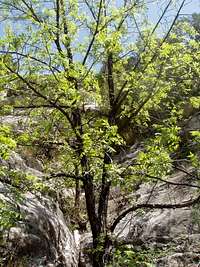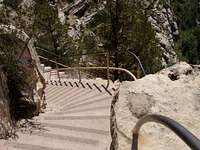|
|
Canyon |
|---|---|
|
|
35.17230°N / 111.5086°W |
|
|
Hiking |
|
|
Spring, Summer, Fall, Winter |
|
|
Overview
Walnut Canyon is just one of several very-worthwhile-to-visit National Monuments in the Flagstaff area. The 3,600 acre monument is situated about 7 miles east of Flagstaff and it protects a portion of the 20-mile long, 400-foot deep canyon containing 700 year old Sinagua cliff ruins. There are two trails here that you can take. One is just a stroll along the top of the canyon and one takes you down a steep staircase into the canyon. Here you will can walk right up to and beside ruins that are remarkably well-preserved because they were protected from the elements under rock alcoves.Walnut Canyon is also unique because of the variety of micro-habitats it contains. It is known as a biological "hot spot" for the abundance and variety of plant and animal life that live here. The canyon serves as a migratory corridor for animals traveling between the lower elevation pinyon-juniper woodland to the higher elevation pine forests.
Geology is also a fascinating thing to observe and study here. It took Walnut Creek 60 million years to carve the canyon out of sandstone and limestone. Today not much water flows through the canyon due to the impoundment of Walnut Creek as a source of water for Flagstaff residents. In rare floods the water from the creek joins the Little Colorado River en route to the Grand Canyon.
Walnut Canyon National Monument was established in 1915 specifically to preserve the ruins. Before its National Monument status it was part of the San Francisco Mountain Reserve (later the Coconino National Forest). It was named after the Arizona or Black Walnut Tree (Juglans major) that grows here. The walnuts were an important part of the Sinagua diet.
Getting There
Walnut Canyon is an easy drive from Flagstaff. Head east on I-40 about 8 miles and take exit 204 (Walnut Canyon Road) then head south 3 miles to the monument visitor center.
Click here for a .pdf map of the monument.
Flagstaff Area Map
Link to a map of Arizona with all its National Parks and Monuments noted
Red Tape
The entrance Fee is $5 per person. America the Beautiful ($80), Access (free), and Senior Passes ($10) are accepted. Click here for more info on these passes!
Backcountry hiking is not allowed in order to protect fragile archaeological sites.
Please practice Leave No Trace ethics!
Camping
There is no campground at Walnut Canyon, but there are many nearby campgrounds in the surrounding National Forest. Check out this link!Trails
The Rim Trail - starts at the visitor center, 0.7 miles, easy, good overall views of Walnut Canyon and you pass by two hill-top ruins.
The Island Trail - starts at the visitor center, 1 mile, strenuous, descends 200 feet along a steep staircase and then you have to come back out. You'll see 25 cliff dwellings along the trail.
External Links
Walnut Canyon National Monument WebsiteLink to current park newspaper
The Remarkable Cliff City of Walnut Canyon
Flagstaff area forecast from the National Weather Service
Explore the nearby San Francisco Volcanic Field





